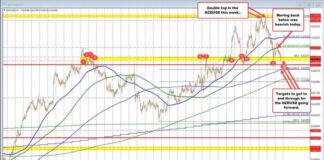The European Central Bank (ECB) is set to convene on Thursday, September 12, amidst growing concerns over the weakening economic outlook in the eurozone. Market analysts widely anticipate that the ECB will consider implementing a rate cut during this meeting to address the challenging macroeconomic conditions facing the region.
Inflation in the eurozone has been edging closer to the ECB’s target of 2%, with longer-term forecasts indicating stability around this level. However, recent economic data paints a different picture, suggesting a slowdown in economic activity across the eurozone. This has prompted the ECB to reassess its monetary policy stance and consider possible measures to support the economy.
One of the key agenda items for the upcoming meeting is the presentation of updated macroeconomic forecasts by the ECB. Analysts predict that these forecasts will likely show downward revisions to inflation projections for 2025 and 2026. Factors such as lower oil prices and a stronger euro are expected to contribute to these revised forecasts, highlighting the challenges faced by the eurozone in achieving price stability.
In addition to inflation forecasts, growth projections for the eurozone may also need to be revised downwards to reflect the current economic conditions. The combination of slowing global growth, trade tensions, and political uncertainties within the eurozone has created a challenging environment for economic expansion. As a result, the ECB may need to adjust its growth expectations to align with the evolving economic landscape.
Despite the likelihood of a rate cut at the upcoming meeting, no new forward guidance is expected to be provided by the ECB. This decision reflects the central bank’s cautious approach to communicating its policy intentions, as it seeks to maintain flexibility in responding to changing economic conditions. Market participants will be closely monitoring the ECB’s press conference following the meeting for any additional insights into the central bank’s policy outlook.
Impact on Financial Markets
The prospect of a rate cut by the ECB has already started to impact financial markets, with investors adjusting their positions in anticipation of potential policy changes. The euro has weakened against major currencies in response to the dovish signals from the ECB, as market participants expect a more accommodative monetary policy stance.
Bond markets have also experienced volatility, with yields on European government bonds falling as investors seek safe-haven assets amid growing economic uncertainties. The possibility of further monetary stimulus from the ECB has fueled demand for government bonds, leading to lower yields across the eurozone.
Stock markets, on the other hand, have exhibited mixed reactions to the prospect of a rate cut. While some sectors, such as export-driven industries, have benefited from the weaker euro, others have faced challenges due to the broader economic slowdown. Investors are closely monitoring the ECB’s decision to assess its implications for different segments of the equity market.
Policy Considerations
The ECB’s decision to consider a rate cut reflects its commitment to supporting economic growth and achieving price stability in the eurozone. By lowering interest rates, the central bank aims to stimulate borrowing and spending, thereby boosting economic activity and inflation. However, there are potential risks associated with this policy approach that the ECB must carefully consider.
One concern is the impact of negative interest rates on the banking sector, which may erode profitability and hinder lending. As banks struggle to generate returns in a low-interest-rate environment, they may become more cautious in extending credit to businesses and consumers, thereby limiting the effectiveness of monetary stimulus.
Another consideration for the ECB is the potential for unconventional monetary policy measures, such as asset purchases or forward guidance. These tools have been used in the past to support the eurozone economy during periods of economic stress, but they also come with their own set of challenges and limitations. The ECB will need to assess the effectiveness of these measures in the current economic environment and determine the appropriate course of action.
Future Outlook
Looking ahead, the ECB’s decision at the September 12 meeting will have significant implications for the eurozone economy and financial markets. The central bank’s ability to navigate the complex economic landscape and implement appropriate policy measures will be crucial in supporting growth and inflation objectives.
Market participants will be closely monitoring the ECB’s communication following the meeting for any signals of future policy actions. The central bank’s ability to provide clarity and guidance on its policy intentions will be key in shaping market expectations and influencing investor sentiment.
Overall, the ECB’s upcoming meeting represents a critical juncture for the eurozone economy as it grapples with mounting challenges and uncertainties. The central bank’s response to these challenges will be closely watched by policymakers, investors, and the public as they seek to understand the path forward for the eurozone economy.

















